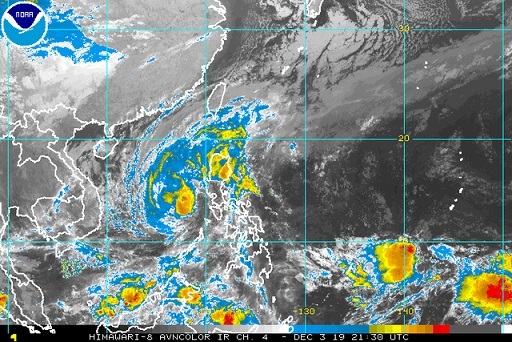
Satellite image of Severe Tropical Storm Tisoy (International name: Kammuri) as of December 4, 2019, 5:30 am. (Image from NOAA)
Typhoon Tisoy (international name Kammuri) exited the country leaving at least three people dead and shutting the capital, causing massive blackouts and damages to properties and forcing work stoppage in government offices, cancellation of classes and disrupting competitions in the 30th Southeast Asian (SEA) Games being hosted by the country.
About 225,000 people were evacuated before the typhoon hit the country.
State weather bureau PAGASA lifted all storm warning signals Wednesday morning as Tisoy headed to the West Philippine Sea (WPS).
As of 10 a.m., Tisoy was last seen 290 kilometers west southwest of Subic, Zambales. It is the country’s strongest storm recorded so far this year, packing maximum winds of 95 km per hour and gustiness of up to 115 kph.
Moderate with occasional heavy rains will prevail over the Ilocos region, Cagayan Valley, Cordillera Administrative Region, and Aurora due to the northeast monsoon or “amihan”.
Moderate to rough seas may also prevail over the western seaboard of Central Luzon and the southern seaboard of Southern Luzon.
PAGASA said Tisoy is expected to exit the Philippine area of responsibility between Wednesday night and Thursday morning if it continues to move west-northwest at 15 kph. Tisoy is the 20th typhoon to hit the country this year.
It packed winds of up to 200 kph (124 mph) damaging homes and structures and uprooting trees and as it barreled through Southern Luzon towards the WPS.
“We’ve seen great improvement in local government management of preparations for disasters,” National Disaster Risk Reduction and Management Council spokesperson Mark Timbal said in an interview over news channel ANC.
Three people were killed as Tisoy tore through Luzon on Tuesday, shutting the capital’s main airport, displacing thousands and causing blackouts.
The fatalities involved a man who was electrocuted while attempting to fix his roof in Camarines Sur province. In Oriental Mindoro, one was killed by a falling tree and the other by a sheet of metal roofing. Officials said the victims ignored mandatory evacuation warnings.
“It could have been more if we did not have pre-emptive evacuation,” Gov. Humerlito Dolor, of Oriental Mindoro province said over radio station DZMM.
Massive power outages were reported in Luzon and Visayas provinces due to the typhoon.
About 28 electric cooperatives or about 1.7 million households were affected by the power outages.
The entire Bicol region experienced a total blackout. Frank Mabitazan, deputy head of the National Grid Corporation of the Philippines said they have yet to assess the damage brought about by the typhoon on the power grid before power can be restored. He, however, assured that power will be back up not more than a week.
Aside from Bicol, Batangas, Laguna at Quezon provinces had no electricity.
About 499 flights were cancelled affecting more than 100,000 passengers after the Ninoy Aquino International Airport was shut down for 12 hours until 11:00 p.m. Tuesday (1500 GMT). However, flights in other parts of the country unaffected by the typhoon continued.
Airlines announced that rebooking of cancelled flights can be done within 30 days for free or passengers have the option for a full refund.
Legazpi City airport was severely damaged by the typhoon as photos and videos posted in social media and showed cables, lighting and panels hanging from the ceiling over the departure areas.
PAGASA warned of storm surges of up to three meters, flooding and landslides could happen. All sea travel was suspended.
Government work and classes in Metro Manila were also suspended.
Outdoor games of the Southeast Asian Games which the country is hosting until Dec. 11 had been suspended among them surfing, kayak, windsurfing, polo, sailing, skateboarding and canoeing. (Rommel F. Lopez)